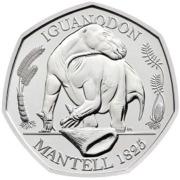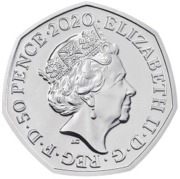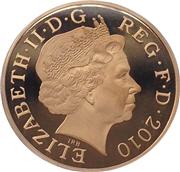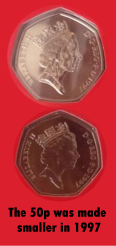 The 2020 50 Pence Coin - Iguanodon
The 2020 50 Pence Coin - Iguanodon This is the second coin in the Dinosauria Collection.
In 1822, Mary Ann Mantell (1795-1869) while out walking with her husband, noticed a large tooth on the side of the road and couldn't recognise it as any animal she had seen before. Her husband Gideon Mantell (1790-1852) was an English obstetrician, geologist and palaeontologist, who immediately began to wonder if it could be from the same creatures that Buckland had found.
There was some debate but eventually it was concluded that this was in the dinosaur family. After finding other bones, Mary sketched out what it may have looked like and thought it was like an Iguana. Gideon wanted to call it an 'Iguana-saurus' but after consultation decided to call it 'Iguanodon'.
Gideon Mantell published a book in 1827 called 'Illustrations of the Geology of Sussex', and it featured some of Mary's illustrations, including the Iguanodon. You can find a free copy of the book if you search the Internet.
On 24 June 2000, the Mantell Monument was unveiled at Cuckfield, West Sussex, at the site that is believed to be the location of the initial discovery. The plaque shows photographs of both Gideon and Mary.
The coin Reverse, by Robert Nicholls, shows the Iguanodon.
 The Obverse shows a portrait of Queen Elizabeth II by Jody Clark.
The Obverse shows a portrait of Queen Elizabeth II by Jody Clark.Besides the BU, the coin is available as Coloured BU, Silver Proof, Coloured Silver Proof and Gold Proof.
Images used by permission of The Royal Mint
Mintage: Not known
Minted at The Royal Mint
Below are some coins currently being offered on eBay. As an eBay Partner, We may be compensated if you make a purchase.
 Queen Elizabeth II was the longest reigning British Monarch ever, reigning for over 70 years. Born on 21 April 1926 to King George VI and Elizabeth Bowes-Lyon, she became Queen in 1952 and her Coronation was on 2 June 1953. She died on 8 September 2022. Some coins were released dated 2023.
Queen Elizabeth II was the longest reigning British Monarch ever, reigning for over 70 years. Born on 21 April 1926 to King George VI and Elizabeth Bowes-Lyon, she became Queen in 1952 and her Coronation was on 2 June 1953. She died on 8 September 2022. Some coins were released dated 2023.Queen Elizabeth II issued many coins and was monarch during decimalisation. She married Prince Philip, Duke of Edinburgh in 1947 and had four children. Her eldest son succeeded the throne as King Charles III. House of Windsor.
The British Fifty Pence (50p) coin was introduced in October 1969 as part of the decimalisation of the British currency. It replaced the 10 shilling note, both being equivalent to half of one pound (£0.50). It is colloquially called the '50 pee'. The coin has 7 sides (heptagonal) but has rounded corners on each apex so that the coin will roll and work in vending machines.  Originally, the coin has a diameter of 30mm and weighed 13.5g, but in 1997 this was replaced with a smaller version of diameter 27.3mm and weight of 8g. The thickness was kept at 1.78mm. The coin is made of Cupro-Nickel (75% copper, 25% nickel). The larger version was demonitised (i.e. ceased to be legal tender) in 1998.
Originally, the coin has a diameter of 30mm and weighed 13.5g, but in 1997 this was replaced with a smaller version of diameter 27.3mm and weight of 8g. The thickness was kept at 1.78mm. The coin is made of Cupro-Nickel (75% copper, 25% nickel). The larger version was demonitised (i.e. ceased to be legal tender) in 1998.
There are four versions of the portrait of Queen Elizabeth II:
- 1969-1984 - Designer: Arnold Machin
- 1985-1997 - Designer: Raphael Maklouf
- 1998-2015 - Designer: Ian Rank-Broadley FRBS
- 2015-2022 - Designer: Jody Clark
There are also 29 different variants which were minted in 2011 in celebration of the 2012 Summer Olympics.
Formed in the reign of Alfred the Great about the year 886, during the period 1279-1812 it was generally referred to as The Tower Mint as it was housed at the Tower of London. The Master of The Royal Mint has included famous figures such as Sir Isaac Newton.
Since 2010 it has operated as Royal Mint Ltd, a company owned by HM Treasury, under an exclusive contract to supply all coinage for the UK although it also produces medals and coins for other countries. It is currently located at Llantrisant, Wales.
The orignal coinage was Pounds, Shillings and Pence but since decimalisation on 15 February 1971, it is £1 = 100p, that is One Pound = 100 pence. The coinage of the UK is also a long history, the Royal Mint being established as long ago as 886AD when coins were hammered. Today there is perhaps 30 billion coins in circulation, and many (numismatic) collectors coins and sets are issued frequently in gold, silver and other metals.
As an eBay Partner, We may be compensated if you make a purchase.








